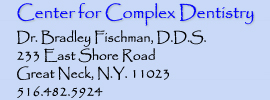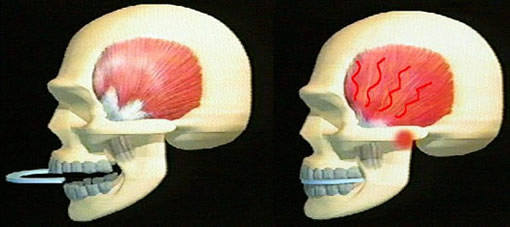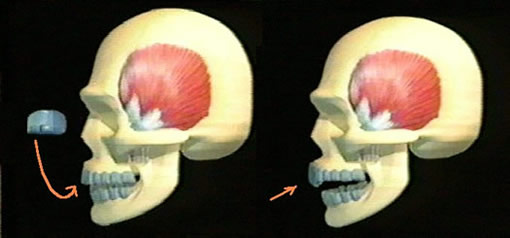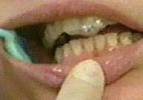 |
 |
The FDA has cleared for marketing for the first time, a device that prevents medically diagnosed migraine pain, tension-type headache, and jaw disorders ("TMJ"), without drugs or surgery, through the reduction of trigeminally innervated muscular activity.
Are you one of those who are uneasy regarding dentistry? Check out the book: "I hate Dentists!" (and the section on the NTI-tss)
 |
|
 |
Migraine Prevention -- Headache Prevention The N.T.I. Tension Suppression System is a prefabricated polycarbonate matrix that a dental practitioner retro-fits to the patient's teeth. It is completely different from any other type of mouthpiece. Here's the rationale. |
 |
Chronic symptoms of the head and neck can often be attributed to: A)Headache -- the temporalis muscle (it closes and clenches the jaw) B) Sinus pressure and pain -- the lateral pterygoid muscles (it moves the jaw side to side and/or forward) C)Neck stiffness and pain -- trapezius muscle (it stabilizes the skull during jaw clenching and grinding |
 |
Contraction of the lateral pterygoid ( B , above) simply moves the jaw sideways (or if both contract, front wards). If the temporalis ( B , above) contracts simultaneously (clenching) , the intensity of the temporalis contraction dictates the degree of resistance the lateral pterygoids encounter when they attempt to move the jaw sideways (grinding) . As temporalis contraction intensity increases, the lateral pterygoids must work harder, creating symptoms where the lateral pterygoid muscle is attached: at the jaw joint and sinuses. This conflicting and/or isometric contracting of the musculature (called "parafunction", which occurs during sleep with considerable intensities) obligates the trapezius (across your upper back and shoulders and attaches at the base of the skull, ( C ), above) to maintain a tightened posture, thereby causing stiff and sore shoulders and/or neck. |

|
|

|
(above) When there is temporalis contraction (clenching) exclusively (no lateral pterygoid activity, that is, not sideways of forward movement), the jaw joint and sinuses are less strained, while resultant temporalis pain may be considerable. Tension-type headache patients without jaw disorders clench their jaws 14 times more intensely while sleeping than do asymptomatic controls You can feel your temporalis muscles bulging out when clenching vigorously. |
 |
"Traditional" full coverage dental mouthpieces. |
 |
|
| A traditional dental mouthpiece, or splint, reduces the resistance to side-to-side movement thereby reducing the effort and resultant strain to the jaw joint and sinuses (so long as clenching intensity isn't too intense). However, the same splint also provides an ideal clenching surface, where maximum clenching intensity may increase and/or allow jaw joint problems to perpetuate. | |
 |
|
| The NTI device is a pre-fabricated matrix that your dentist retro-fits and customizes to your front teeth (sometimes the device is adapted to the lower front teeth...it will still work the same). |
|
 |
If only the front teeth are engaged (like biting on a pencil, for example), the temporalis is prevented from achieving its maximum contraction intensity! The NTI device snaps into place and fits comfortably on either the upper or lower front teeth. It is worn during sleep and prevents the intensity of muscular parafunction. For migraine sufferers, there is a more discreet version for daytime use, which is usually required (in addition to the pictured nighttime device) for 6 to 8 weeks for best results. Chronic, intense nighttime muscular parafunction has been shown to be a considerable influence on the triggering of migraine events. In clinical trials, 82% of medically diagnosed migraine patients had a 77% reduction in migraine episodes within the first eight weeks of use. |
 |
|
Dentures | Extreme Makeovers | Doctor's Credentials | Map & Policies | Contact Us
Home | Professional Referrals | Tidbits for Dentists | Newsletters for MDs
Website Designed by: Monmouth Web Developers